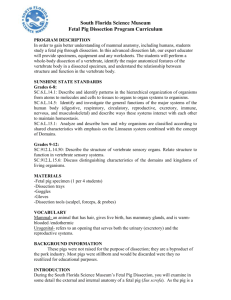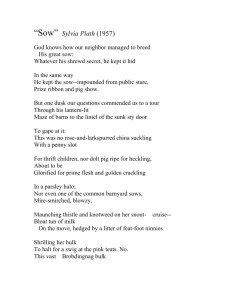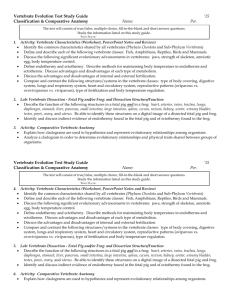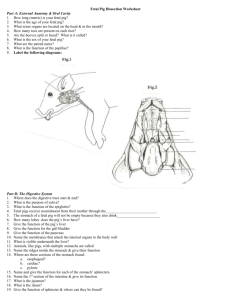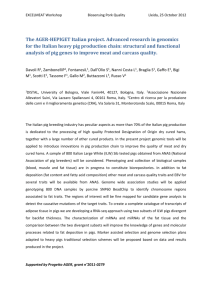Vertebrate Anatomy & Physiology: Fetal Pig
advertisement
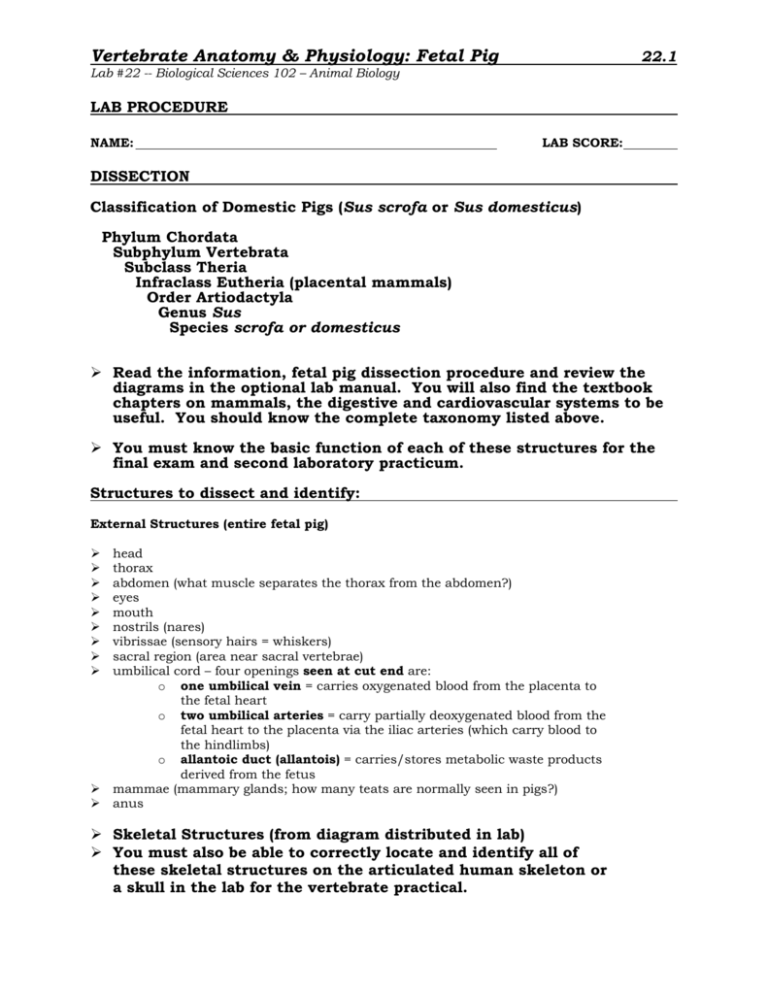
Vertebrate Anatomy & Physiology: Fetal Pig 22.1 Lab #22 -- Biological Sciences 102 – Animal Biology LAB PROCEDURE NAME: LAB SCORE: DISSECTION Classification of Domestic Pigs (Sus scrofa or Sus domesticus) Phylum Chordata Subphylum Vertebrata Subclass Theria Infraclass Eutheria (placental mammals) Order Artiodactyla Genus Sus Species scrofa or domesticus ¾ Read the information, fetal pig dissection procedure and review the diagrams in the optional lab manual. You will also find the textbook chapters on mammals, the digestive and cardiovascular systems to be useful. You should know the complete taxonomy listed above. ¾ You must know the basic function of each of these structures for the final exam and second laboratory practicum. Structures to dissect and identify: External Structures (entire fetal pig) ¾ ¾ ¾ ¾ ¾ ¾ ¾ ¾ ¾ ¾ ¾ head thorax abdomen (what muscle separates the thorax from the abdomen?) eyes mouth nostrils (nares) vibrissae (sensory hairs = whiskers) sacral region (area near sacral vertebrae) umbilical cord – four openings seen at cut end are: o one umbilical vein = carries oxygenated blood from the placenta to the fetal heart o two umbilical arteries = carry partially deoxygenated blood from the fetal heart to the placenta via the iliac arteries (which carry blood to the hindlimbs) o allantoic duct (allantois) = carries/stores metabolic waste products derived from the fetus mammae (mammary glands; how many teats are normally seen in pigs?) anus ¾ Skeletal Structures (from diagram distributed in lab) ¾ You must also be able to correctly locate and identify all of these skeletal structures on the articulated human skeleton or a skull in the lab for the vertebrate practical. Vertebrate Anatomy & Physiology: Fetal Pig Lab #22 -- Biological Sciences 102 – Animal Biology ¾ You must be able to correctly locate and identify all of these bones on a frog, crocodilian, bird (pigeon), pig or human skeleton (as seen in each species) or diagram of each skeleton (some bones are not found in every vertebrate group). Skeletal Structures (from diagram in lab) ¾ ¾ ¾ ¾ ¾ ¾ ¾ ¾ ¾ ¾ ¾ ¾ ¾ ¾ ¾ ¾ ¾ ¾ ¾ ¾ ¾ ¾ ¾ ¾ ¾ ¾ ¾ ¾ ¾ ¾ ¾ ¾ ¾ ¾ ¾ ¾ ¾ ¾ ¾ ¾ ¾ ¾ ¾ ¾ skull facial region (face) cranial region (cranium) axial skeleton (skull, all vertebrae, ribs, sternum & hyoid bone) appendicular skeleton (all bones of arms/forelimbs and legs/hindlimbs) maxillae (upper jaw bones) mandible (lower jaw bone) incisor teeth (where and how many in adult humans and pigs?) canine teeth (where and how many in adult humans and pigs?) premolar teeth (where and how many in adult humans and pigs?) molar teeth (where and how many in adult humans and pigs?) zygomatic arch (encloses muscles that close the jaw) external auditory meatus (external hole to ear canal) foramen magnum (hole in parietal bone for spinal cord) vertebrae (backbones – cervical, thoracic, lumbar and sacral) atlas (first cervical vertebrae) axis (2nd cervical vertebrae in humans) cervical vertebrae (where and how many?) thoracic vertebrae (where and how many?) lumbar vertebrae (where and how many?) sacral vertebrae (where and how many?) caudal (tail) vertebrae (where and how many?) ribs (how many pairs of ribs in humans?) costal cartilages (connect ribs to sternum) sternum (manubrium and xiphisternum/xiphoid process) scapula (shoulder blade) clavicle (collar bone) humerus (arm bone) radius (forearm/limb bone) ulna (forearm/limb bone carpals (how many of these in a pig? a human?) metacarpals (how many in a pig? how many in a human?) forelimb phalanges (digits – how many in each foot of a pig? how many in each hand & foot of humans?) pelvis (what bones comprise the pelvis in a pig and a human?) innominate bone (os coxa = ilium, ischium and pubis – where is each bone that comprises the pelvis in both pig and human?) acetabulum (a feature of the innominate bone) femur (thigh bone) patella (kneecap) tibia (leg/hindlimb bone) fibula (leg/hindlimb bone) tarsals (how many of these in a pig? a human?) fibular tarsal/calcaneus = heelbone metatarsals (how many in a pig? how many in a human?) hindlimb phalanges (digits – how many in each foot of a pig? how many in each hand & foot of humans?) 22.2 Vertebrate Anatomy & Physiology: Fetal Pig Lab #22 -- Biological Sciences 102 – Animal Biology Muscular System (see lab diagrams – do not cut through these until you have shown your instructor that you know their anatomical location and can identify them) ¾ For each of these muscles, you must also know the ACTION of the muscle as listed in the tables distributed in lab for the final examination and the vertebrate lab practical. Indicate the action of each muscle on the lines next to each muscle name. Muscles (from diagrams in lab) Muscles of the Forequarter ¾ masseter – action = ¾ superficial pectoral – action = ¾ deep pectorals (collectively) – action = ¾ trapezius (you must at least partially reflect or remove one side of this muscle to see deeper muscles such as rhomboideus) – action = ¾ latissimus dorsi – action = ¾ deltoid – action = ¾ rhomboideus – action = Muscles of the Foreleg ¾ biceps (collectively) = anterior – action = ¾ triceps (collectively) = posterior – action = Muscles of the Abdomen, Back and Hip ¾ external and internal obliques (collectively) – action = ¾ rectus abdominus – action = ¾ biceps femoris (near hindleg) – action = ¾ gluteus medius – action = Muscles of the Hindleg ¾ quadriceps group (collectively) – action = ¾ sartorius – action = ¾ semimembranosus (“hamstring”) – action = ¾ semitendinosus (“hamstring”) – action = 22.3 Vertebrate Anatomy & Physiology: Fetal Pig 22.4 Lab #22 -- Biological Sciences 102 – Animal Biology Head - Internal Structures in the Mouth ¾ ¾ ¾ ¾ ¾ ¾ ¾ ¾ ¾ hard palate (roof of mouth – separates nasal and oral cavities) soft palate (what is the function of this structure?) epiglottis (what is the function of this structure?) tongue (for mastication/chewing and important for speech in humans) opening to esophagus (in oral cavity) nasopharynx (posterior region of nasal cavity) Eustacian (auditory) tube (allows air to flow from pharynx to middle ear) parotid glands & parotid ducts (ducts may not be visible) = produce saliva submaxillary glands = produce saliva Neck & Thoracic Organs – Internal Structures ¾ ¾ ¾ ¾ ¾ ¾ ¾ ¾ ¾ ¾ ¾ ¾ ¾ ¾ ¾ ¾ ¾ ¾ ¾ ¾ ¾ larynx (“voicebox”) trachea (tube that carries air to bronchi that convey air to lungs) tracheal (cartilaginous) rings (hold trachea open) esophagus (posterior to trachea; conveys food to stomach by peristalsis) thymus (immune organ where T cells of immune system mature) pericardium (lubricating membrane around heart) heart (4 chambered) pleura (lubricating membrane around lungs) lungs (right = 3 lobes, superior, middle, inferior; left = 2 lobes, superior & inferior) diaphragm (separates thorax from abdomen – contracts during inspiration) aortic arch (blood to head and body from left ventricle) brachiocephalic artery (trunk) (blood to right side of head and right forelimb/arm) left common carotid artery (blood to left side of head) left subclavian artery (blood to left forelimb/arm) descending aorta (blood to thorax, abdomen & hindlimb/legs) right subclavian vein (blood from right forelimb/arm to precava ) left subclavian vein (blood from left forelimb/arm to precava ) external jugular veins (blood from superficial head structures to precava ) internal jugular veins (blood from deep head structures and brain to precava ) precava (superior vena cava) (blood from head and arms to right atrium) postcava (inferior vena cava) (blood from abdomen and legs to right atrium) Thoracic, Abdominal & Pelvic Organs – Internal Structures ¾ ¾ ¾ ¾ ¾ ¾ ¾ ¾ ¾ ¾ ¾ ¾ ¾ ¾ lungs (for ventilation and gas exchange) heart (four chambered for pumping blood into pulmonary and systemic circuits) pericardial sac (double layer of lubricating serous membranes around heart) left atrium of heart left ventricle of heart right atrium of heart right ventricle of heart coronary arteries (on heart to supply heart muscle with blood) aortic arch and dorsal (descending) aorta (blood to head and body from left ventricle) posterior (inferior) vena cava (postcava; blood from legs/hindlimbs and abdomen) remove the heart to view the interventricular septum between the two ventricles, atrioventricular valves, chordae tendinae, papillary muscles and interior of chambers) liver (many, many functions; bile production, storage, plasma proteins, etc. – see notes) gallbladder (stores bile from liver conveyed to duodenum via cystic and common bile ducts) stomach (multiple functions, produces HCl acid, pepsin enzyme and mucous – see notes) Vertebrate Anatomy & Physiology: Fetal Pig 22.5 Lab #22 -- Biological Sciences 102 – Animal Biology Thoracic, Abdominal & Pelvic Organs – Internal Structures ¾ ¾ ¾ ¾ ¾ ¾ ¾ ¾ ¾ ¾ ¾ ¾ ¾ ¾ ¾ ¾ ¾ ¾ ¾ rugae of stomach (folds of stomach lining to allow stomach to expand and increase surface area of stomach mucous membrane) small intestines (supported by mesenteries; for digestion and absorption of nutrients) mesenteries (visceral peritoneum = lubricating membrane covering abdominal organs) parietal peritoneum (lubricating serous membrane attached to body wall) duodenum (multiple functions, first portion of small intestines that receives pancreatic, liver and gallbladder secretions to begin enzymatic/chemical digestion of nutrients) jejunum (middle portion of small intestines with large plical folds in lining to increase surface area for absorption of nutrients) ileum (last portion of small intestines with smaller plical folds; connects to cecum) cecum/spiral colon (absorption of water and digestion of cellulose in pigs) rectum (straight portion of large intestine leading to the anus) pancreas (inferior to the stomach; both an exocrine and endocrine organ with many functions – see notes) spleen (lymphatic organ on left that breaks down old, degenerating erythrocytes/RBCs) kidneys (many functions; diuresis = urine production; osmoregulation & pH balance, etc.) renal cortex (superficial portion of kidney) renal pelvis/medulla (deeper portion of kidney) ureters (muscular tubes that convey urine from kidneys to urinary bladder) urinary bladder (lined with transitional epithelium; stores urine) gonads (ovary = female or testes = male = produce gametes and sex hormones) oviducts (female = for egg and sperm transport/gestation of young in uterine horns) ductus/vas deferens (male = convey stored sperm from epididymis at ejaculation) Head Internal Structures – The Brain and Spinal Cord (do this last!) spinal cord (conveys neural information via peripheral nerves to and from the brain) olfactory nerves (as visible for chemoreception/smell) olfactory lobes (for processing of chemoreception/smell) cerebrum (cerebral hemispheres = many portions for neural information processing) longitudinal fissure (large groove between left and right hemispheres) gyri (folds of neural tissue/cortex of the brain) sulci (grooves between gyri in the brain) optic nerves (2nd cranial nerves; convey visual information from retina to brain) cerebellum (motor coordination & balance; planning and execution of voluntary movements) ¾ pons (part of brainstem) ¾ medulla oblongata (part of brainstem) The brainstem consists of the medulla, the pons and the midbrain. All input and output fibers traversing from the peripheral nervous system to higher brain centers must first pass through the brainstem. Incoming fibers carry sensory information while outgoing fibers carry command signals. Most of the 12 cranial nerves arise from the brainstem The brain stem is responsible for: 1. the control of heart & blood vessel function, respiration and much of digestion 2. helps modulate the sense of pain 3. regulates reflexes involved in equilibrium and posture 4. houses a reticular formation that integrates all synaptic input which is important in the ability to direct attention; there are fibers that originate here and carry signals that can arouse and activate the cerebral cortex 5. houses the sleep centers ¾ ¾ ¾ ¾ ¾ ¾ ¾ ¾ ¾ Vertebrate Anatomy & Physiology: Fetal Pig Lab #22 -- Biological Sciences 102 – Animal Biology LABORATORY NOTES: 22.6


